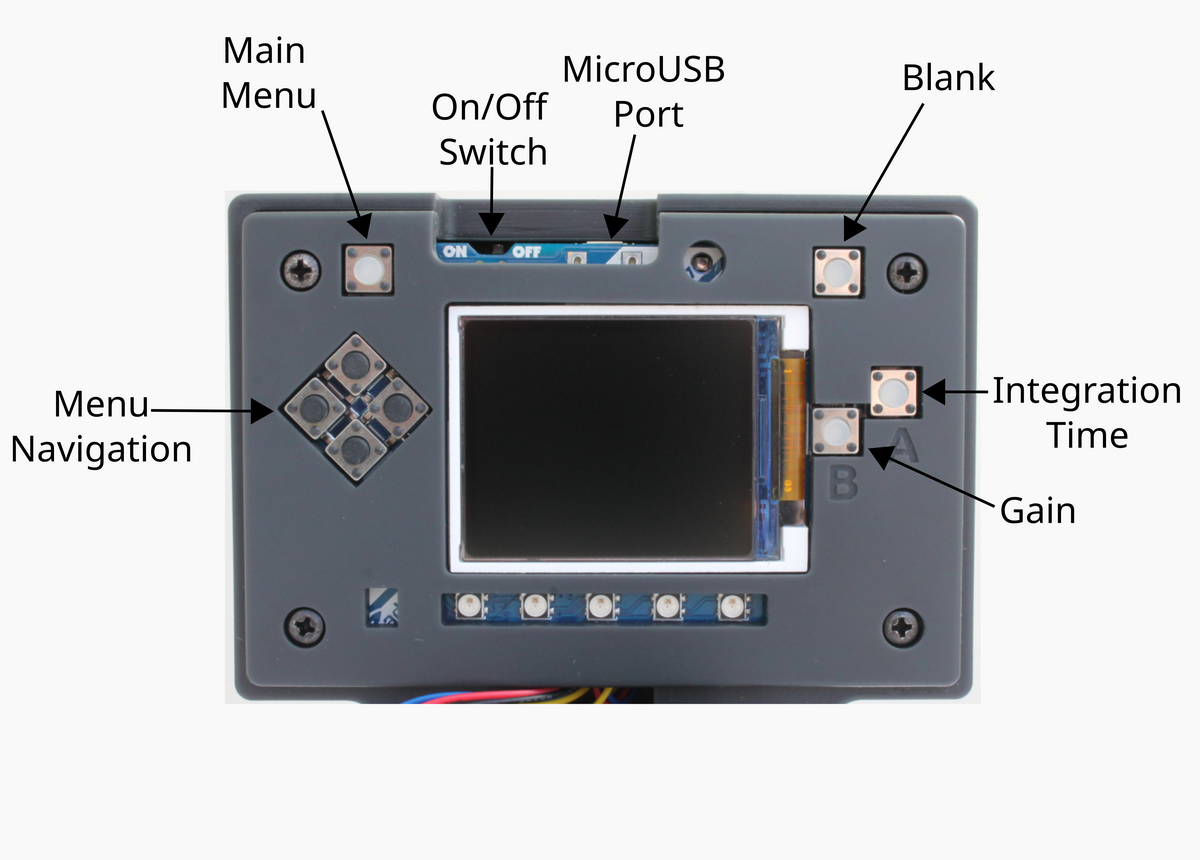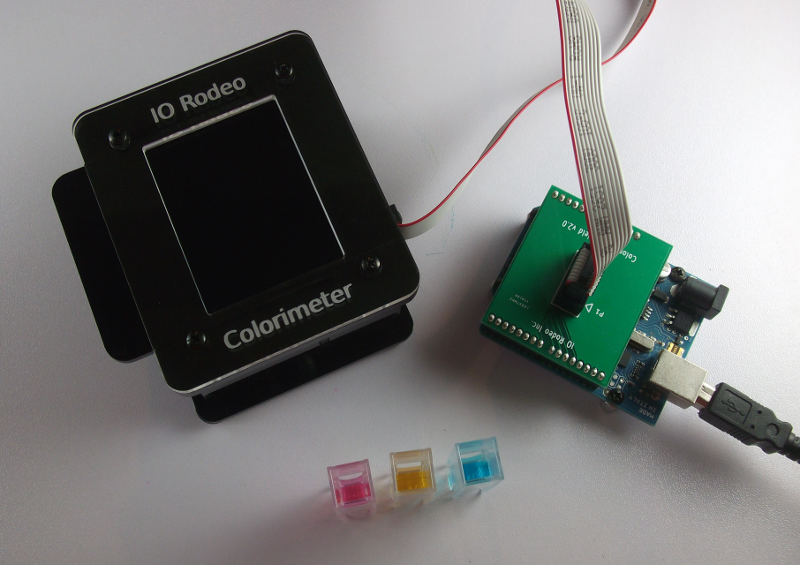Open Colorimeter Product Guide

This is the documentation site for the Open Colorimeter and new variants including the Multi-Channel Colorimeter, UV Open Colorimeter and Open Colorimeter Plus. Instruments in the Open Colorimeter product line are open hardware science designs with wide-ranging applications. They are standalone, portable instruments which can be used either in the lab, classroom or for measurements out in the field.
Listed below are user guides and tutorials as well as documentation pages for the hardware designs and CircuitPython firmware.
We will be updating and adding to this documentation site over time. However, if you can't find the information you need in the Product Guide please contact us at info@iorodeo.com or fill out our contact form.
Introduction
Open Colorimeter Product Line Overview
There are several versions of the Open Colorimeter available. The main differences between them are the light sensor used and it’s positioning in respect to the LED light source. The LED light source is also highly customizable. We have a wide-selection of LED wavelengths in the UV, visible and IR

Introduction: Absorbance & Fluorescence Measurements
The Open Colorimeter instruments can be used to measure absorbance, fluorescence and light-scattering as described in this page. Absorbance Measurements Colorimeters are used to quantify the concentration of an analyte in a sample based on the amount of light of a specific wavelength that is absorbed by the test sample.

Getting Started
Getting Started: Basic Operation & Menu Navigation
These instructions below apply to all variants of the Open Colorimeter. The Open Colorimeter has the following features: * On/Off switch: An on-off switch will save battery power when not in use * Micro USB Port: You can power from the Micro USB port and it will also charge up the

Getting Started: Open Colorimeter Plus
These instructions apply to Open Colorimeter Plus version only. For basic menu navigation instructions, see this page. Getting Started: Basic Operation & Menu NavigationThese instructions below apply to all variants of the Open Colorimeter. The Open Colorimeter has the following features: * On/Off switch: An on-off switch will save battery power

Open Colorimeter Tests & Tutorials
Open Colorimeter Cuvettes
The Open Colorimeter products ship with a small pack of cuvettes to get you started using the instrument. The type of cuvette included depends on the instrument: * Open Colorimeter & Multichannel Open Colorimeter: Pack of 6 BrandTech macro and semi-micro cuvettes (3 of each) * UV Open Colorimeter: Pack of 4 BrandTech

Open Colorimeter Tests
Colorimeters are extremely flexible and easy to use lab instruments. Below are just some examples of how colorimeters are used: * Water quality testing: there are a wealth of colorimetric assays for measuring water parameters such as water turbidity, chlorine content, pH, water hardness, phosphate…

Open Colorimeter Tutorials - IO Rodeo Blog

Open Source Hardware
3D printed cuvette/tube holders and PyBadge enclosure
Cuvette/tube holders The Open Colorimeter’s LED boards and light sensor electronics are mounted onto a 3D-printed black resin cuvette/tube holder. Currently we have two different versions of cuvette/tube holders outlined below. Standard tube/cuvette holder * Used with the Open Colorimeter, UV Open Colorimeter and Multichannel Colorimeter versions

Open Colorimeter Electronics
Communication with peripheral devices via I2C using 4-wire cables with JST SH connectors, such as Sparkfun Qwiic or Adafruit STEMMA QT, is rapidly becoming a standard on new development boards. This standardized cabling allows multiple sensors to be connected to the development board without any soldering. By using these standardized

Open Colorimeter LED Boards
We have also developed a series of UV, visible and IR LED boards which can be used to customize the Open Colorimeter, UV Open Colorimeter and Open Colorimeter Plus. Currently we have 27 wavelengths available in both surface mount and radial form factors: * 18 Surface mount LEDs: UV, visible, & IR

Light Sensor Boards
As mentioned in the Introduction, the different variants use different light sensor boards. Here we will go into these sensors in more detail. Some similarities we won’t go into deatil but all of these light sensors have the same form factor and standard 4-pin JST SH connectors (also called STEMMA

Open Source Firmware
Open Colorimeter CircuitPython Firmware
The Open Colorimeter ships ready-to-use and pre-programmed with firmware, so you do not need to be a programmer to use it! The firmware for the Open Colorimeter is programmed using CircuitPython which is a version of the Python programming language designed to run on microcontrollers. CircuitPython is very easy to

Installing/upgrading the firmware
In this set of notes we describe how to upgrade or reinstall the firmware on your Open Colorimeter. These instructions can be used whever there is a new firmware release that has new features that you would like to use. There are three steps: * Step One: Download and unzip the

Customizing configuration and calibration files
The Open Colorimeter ships pre-programmed with the circuitpython firmware. This page describes how to modify the firmware default settings to customize your instrument. Customizing the Open Colorimeter can make it more convenient to use, reduce setup time, help prevent user errors and ensure consist…

Optimizing the light sensor settings
The Open Colorimeter uses a TSL2591 light sensor, as described in the electronics page. In these notes we describe the light sensor settings and how to adjust them in order to achieve the best results. Open Colorimeter ElectronicsElectronics The Open Colorimeter uses STEMMA QT connectors. Communi…

Installing/upgrading CircuitPython and the bootloader
As new versions of CircuitPython come out you may want/need to upgrade the version of CircuitPython (or bootloader) running on your Open Colorimeter’s PyBadge. These notes describe how this can be done. Prior to upgrading the bootloader or version of CircuitPython make sure to copy any files you do…

Calibration Files and Custom Calibration Tools
Overview of Open Colorimeter calibration files
This page gives some more information on the calibrations.json file which is used to load custom calibrations onto the Open Colorimeter. This file contains calibration data for measurements and the individual entries in this file become the tests which are displayed in the Open Colorimeter’s menu. They are displayed

Creating custom calibrations using oc-cal
In this set of notes we describe how to create custom calibrations for the Open Colorimeter using the command line program oc-cal. This program is part of the open-colorimeter-utils package which is available on PyPi (The Python Package Index). To use oc-cal you will need a working version of Pyt…

Creating custom calibrations using oc-calibration-app
In this set of notes we describe how to generate custom calibrations for the Open Colorimeter using a simple web app called the oc-calibration-app. This app makes fitting your calibration data and generating the required .json file for your colorimeter quick and easy. The app is developed using the…

Purchase an Open Colorimeter
Open Colorimeter
The Open Colorimeter is a portable and customizable colorimeter for measuring absorbance, transmittance and concentration. The cuvette holder and enclosure are made from 3D-printed black nylon material and the electronics are programmed with open source firmware written in CircuitPython.

Multichannel Open Colorimeter
The Multichannel Open Colorimeter is a photometer for measuring light absorbance through samples in a standard 10mm pathlength cuvette. The device uses the Adafruit AS7341 10-Channel Light Sensor. The AS7341 light sensor is an multichannel light sensor with 8 channels covering the visible light spectrum from 415-680 nm

UV Open Colorimeter
The UV Open Colorimeter is a single-wavelength photometer for measuring UV light absorbance through samples in a standard 10mm pathlength cuvette. Applications include protein quantification with a UV LED. The device uses our AS7311 UV sensor board and a PyBadge pre-programmed with open source CircuitPython firmware.

Related Links
The Educational Colorimeter Kit (v1.0)
We initially designed the colorimeter as an Educational Kit in 2012 supported by Kickstarter backers. Educational colorimeter kitKit for making a programmable colorimeter for analytical chemistry and biochemistry labs & activities. Arduino compatible.Kickstarter Documentation for the original Educ…

If you have any questions please feel free to reach out via our contact form.
Documentation License
Documentation licensed under Creative Commons Attribution 4.0 International (CC BY 4.0).











Comments ()